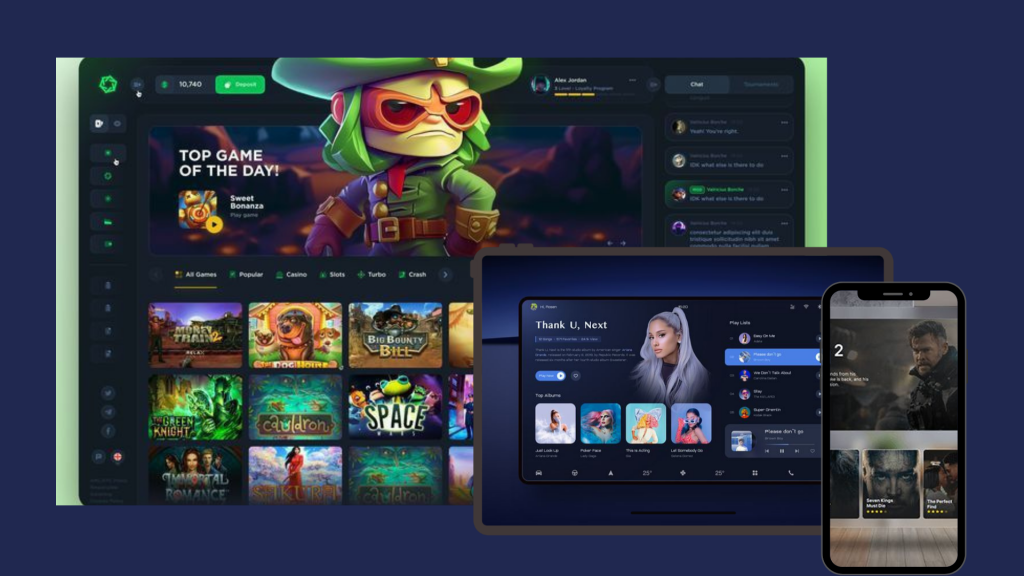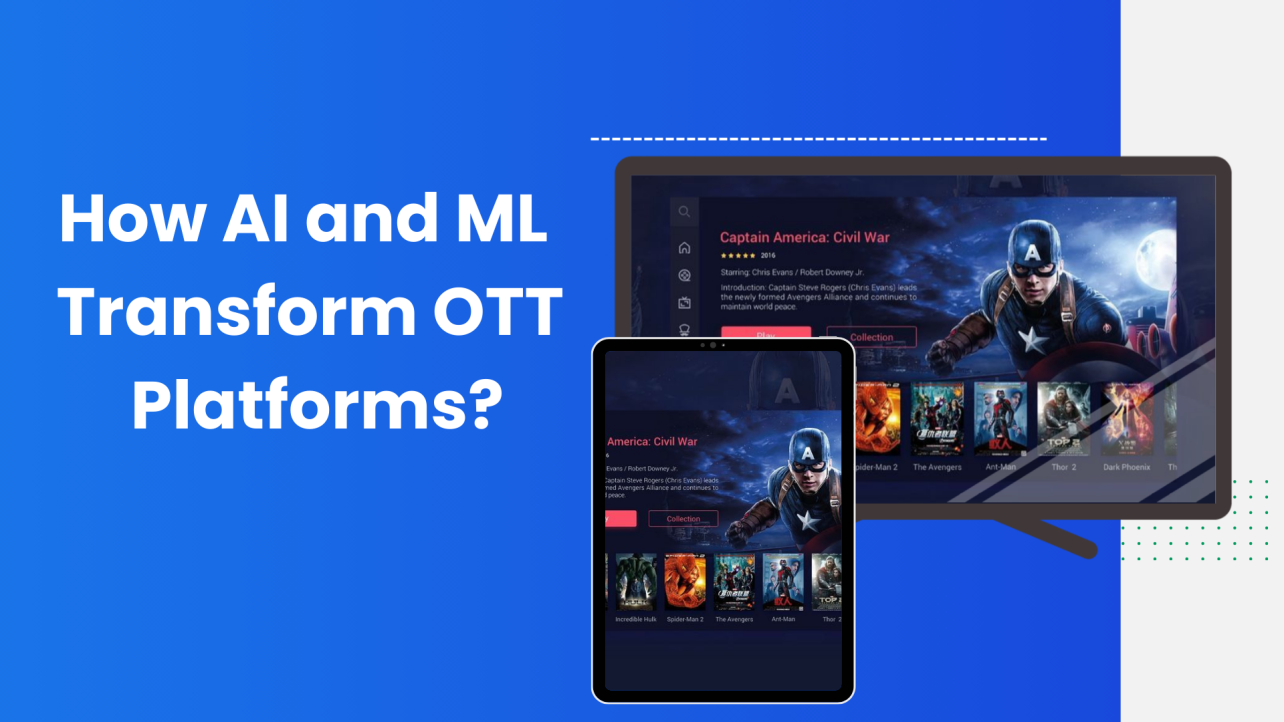Introduction – Why OTT Platforms Need AI and ML to Stay Ahead
Think about the last time you opened Netflix, Prime Video, or Disney+. Within seconds, you probably had a list of shows or movies recommended just for you. That’s not a coincidence—it’s Artificial Intelligence (AI) and Machine Learning (ML) quietly working in the background to make sure you don’t spend 30 minutes scrolling before finally giving up.
OTT platforms have completely changed the way we watch entertainment. People no longer wait for prime-time TV or buy DVDs; everything is available instantly, on-demand, and across devices. But with this convenience comes a big challenge: too much content and too many choices.
For streaming platforms, it’s a double-edged sword. They need to keep users engaged, prevent subscription cancellations, deal with piracy, and deliver smooth playback without buffering. That’s a lot to handle. Traditional strategies just don’t cut it anymore.
This is where AI and ML step in. They’re not just “nice-to-have” tools—they’re becoming essential to running a successful OTT business. From personalized recommendations to smarter security, these technologies are powering almost every part of the streaming experience. Let’s break down how.
The Role of AI and ML in Transforming OTT Streaming
At its core, AI is about teaching machines to think a bit like humans, while ML is about helping them learn from data over time. OTT platforms generate mountains of data every single day—what people watch, when they watch, how long they stick around, what devices they use.
Without AI, this data would just sit there, overwhelming and useless. With AI and ML, platforms can:
- Understand user behavior in detail.
- Predict what content will click with different audiences.
- Deliver smoother streaming by adjusting to internet conditions.
- Keep accounts safe from fraud and piracy.
In short, AI and ML are the invisible engines that make streaming platforms feel smarter, faster, and more personal.
Personalized Content Recommendations – The Heart of AI in OTT
We’ve all been there opening a streaming app and instantly seeing a “Because you watched…” section that’s weirdly accurate. That’s the power of personalization.
Here’s how it works: AI looks at your watch history, your favorite genres, the time of day you usually stream, and even subtle things like how often you pause or skip scenes. It then creates a unique “profile” for you and suggests content you’re likely to enjoy.
Netflix, for example, has admitted that over 80% of what people watch on its platform comes from recommendations. Without this, most users would probably get lost in the sea of thousands of shows and end up frustrated.
The result? You spend less time searching and more time watching—which is exactly what keeps you subscribed.
Smarter Video Streaming With AI and ML
The quality of streaming is just as important as the content itself. Even the best show will fail to engage if buffering interrupts the experience. AI ensures smarter content delivery in several ways:
- Adaptive Bitrate Streaming (ABR): Instead of sticking to one resolution, AI adjusts quality dynamically. For example, if a user moves from a high-speed Wi-Fi connection to mobile data, the system automatically shifts resolution to prevent buffering.
- Predictive Buffering: ML models analyze network patterns and pre-load portions of content before a slowdown happens. This proactive approach makes streams smoother.
- Content Tagging and Metadata Enrichment: AI auto-generates detailed metadata—genres, moods, themes—allowing more precise search results. Imagine typing “crime thriller with strong female lead” and instantly finding the perfect show.
The result is a frictionless streaming experience that users often take for granted but is powered by complex AI decision-making.
AI-Powered Video Analytics – Understanding Audiences Better
One of the biggest advantages of AI in OTT is its ability to turn massive amounts of viewing data into insights for business strategy.
Applications of AI in Analytics
- Content Acquisition: AI predicts which shows or movies will resonate with specific demographics before they are even licensed.
- Marketing Decisions: Platforms can target promotions for new releases to the right audience segments.
- Viewer Retention: Analytics show when users are most likely to cancel subscriptions, allowing platforms to intervene with offers or new recommendations.
Example
Some streaming platforms run A/B tests with multiple trailers for the same show. AI then analyzes which version generates the most clicks and uses that version globally. This data-driven approach ensures maximum engagement while reducing marketing waste.
By applying AI in analytics, platforms make smarter investments in content and marketing, ensuring higher returns and audience satisfaction.
Enhancing Security and Combating Piracy With AI
Streaming platforms deal with another headache: piracy and account misuse. This is where AI’s protective side kicks in.
- Password Sharing Detection: AI can spot unusual login patterns, like one account being used on multiple devices in different cities at the same time.
- Piracy Monitoring: ML-powered tools scan the internet for illegal uploads of copyrighted content. Combined with digital watermarking, this makes it easier to trace leaks.
- Fraud Detection: AI keeps an eye out for suspicious payment activities or fake ad clicks, saving platforms from revenue losses.
These measures help OTT providers maintain trust with content creators and ensure they don’t lose money to bad actors.

Monetization Strategies Made Smarter by AI
OTT platforms rely on monetization models such as Subscription Video on Demand (SVOD), Advertising Video on Demand (AVOD), and Transactional Video on Demand (TVOD). AI plays a critical role in maximizing revenue across all these models:
- Personalized Ads: Instead of generic advertising, AI matches users with ads they are likely to engage with. For example, sports fans might see fitness products, while a family viewer might see holiday promotions.
- Dynamic Subscription Pricing: ML models test various pricing tiers and discounts, identifying which users are most sensitive to price changes and offering tailored deals to retain them.
- Optimized Content Placement: AI predicts which titles are best suited for premium placement on homepages, driving higher rentals or purchases.
This intelligent monetization ensures that OTT platforms maintain profitability without compromising the user experience.
AI-Powered Customer Experience and Support
Customer support is another area where AI is revolutionizing OTT platforms.
- Chatbots and Virtual Assistants: These can instantly answer FAQs about billing, device compatibility, or content availability, reducing wait times for users.
- Multilingual Capabilities: AI-powered Natural Language Processing (NLP) allows support across multiple languages, enabling global expansion.
- Predictive Support: By analyzing usage data, AI can detect if a user is having recurring playback issues and proactively provide solutions before the user even raises a complaint.
These features ensure a seamless support system that increases satisfaction while reducing operational costs for platforms.
The Future of AI and ML in OTT Streaming
Here’s the exciting part: we’re only scratching the surface of what AI can do for OTT. The future looks even smarter.
- Predictive Audience Modeling: Platforms will be able to simulate entire user groups and predict what shows they’ll like before launch.
- Voice and Visual Search: Imagine searching for a movie just by describing it or uploading a screenshot of an actor.
- Automated Localization: AI could instantly generate subtitles, dubbing, and even culturally adapted versions of content.
- AI-Generated Content: Trailers, teasers, and even highlight reels could be created automatically, saving time and resources.
- Hyper-Personalization: No two users will ever see the same homepage. Every single experience will be tailor-made.
The future of OTT is clearly going to be AI-first.
Conclusion – Why AI and ML Are the Future of OTT Success
The OTT industry has transformed entertainment, but let’s be real—having a massive content library isn’t enough anymore. Viewers want platforms that understand them, stream smoothly, stay secure, and give value for money.
That’s exactly what AI and ML bring to the table. They’re not just tools for better recommendations—they’re powering everything from security to monetization, from user experience to global expansion strategies.
Platforms that adopt AI now will set themselves apart, while those that ignore it risk being left behind. The future of streaming is smarter, faster, more personal, and more secure—and AI is the technology making it happen.
For businesses and content providers, the time to invest in AI-driven solutions is now. The future of OTT streaming is intelligent, data-driven, and user-centric — and AI is the key to unlocking that future.


No comments yet